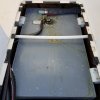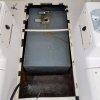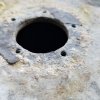- Joined
- Nov 19, 2018
- Messages
- 11
- Reaction score
- 1
- Points
- 3
- Age
- 67
- Model
- Adventure
First time owner and first post! Just purchased a 1996 Adventure 208 in need of TLC. So, first order of business, I removed the fuel sender unit and removed 25 gallons of 3 year old fuel. First 5 gallons was pretty milky; I’m not planning on attempting to use any of the 25 gallons. Wow, expensive to get rid of it!
First question: does this look like the original tank? Please see photo; the 2x4’s securing the tank are toe-screwed into the fiberglass bulkheads running fore-aft. Pretty ugly workmanship, which makes me think this is a replacement tank? That would be a pleasant surprise!
Second question: I removed water tank to see why there was water in the bilge below the fuel tank and not draining aft. Unfortunately, there’s a “shelf” below the water tank and I cannot access / assess how bilge drains to the rear bilge. Any thoughts? I used a wet/dry vac and got as much bilge water out as possible. Now that we’re back to freezing temps, I have a 1” skating rink in the bilge. Should I be concerned?
Many thanks; from what I’ve read so far, this site/ forum is a wealth of info and experience. Happy Thanksgiving! CT
First question: does this look like the original tank? Please see photo; the 2x4’s securing the tank are toe-screwed into the fiberglass bulkheads running fore-aft. Pretty ugly workmanship, which makes me think this is a replacement tank? That would be a pleasant surprise!
Second question: I removed water tank to see why there was water in the bilge below the fuel tank and not draining aft. Unfortunately, there’s a “shelf” below the water tank and I cannot access / assess how bilge drains to the rear bilge. Any thoughts? I used a wet/dry vac and got as much bilge water out as possible. Now that we’re back to freezing temps, I have a 1” skating rink in the bilge. Should I be concerned?

Many thanks; from what I’ve read so far, this site/ forum is a wealth of info and experience. Happy Thanksgiving! CT





